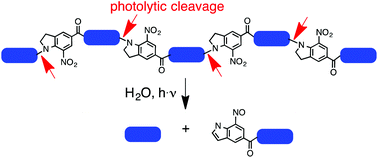当前位置:
X-MOL 学术
›
Org. Biomol. Chem.
›
论文详情
Our official English website, www.x-mol.net, welcomes your feedback! (Note: you will need to create a separate account there.)
Synthesis and characterization of a photocleavable collagen-like peptide†
Organic & Biomolecular Chemistry ( IF 3.2 ) Pub Date : 2018-01-09 00:00:00 , DOI: 10.1039/c7ob02198d Alfredo Ornelas 1, 2, 3, 4 , Kaitlyn N. Williams 1, 2, 3, 4 , Kevin A. Hatch 2, 3, 4, 5 , Aurelio Paez 2, 3, 4, 6, 7 , Angela C. Aguilar 2, 3, 4, 5 , Cameron C. Ellis 2, 3, 4, 8 , Nishat Tasnim 2, 3, 4, 6, 7 , Supriyo Ray 1, 2, 3, 4 , Carl W. Dirk 1, 2, 3, 4 , Thomas Boland 2, 3, 4, 6, 7 , Binata Joddar 2, 3, 4, 6, 7 , Chunqiang Li 2, 3, 4, 5, 9 , Katja Michael 1, 2, 3, 4, 9
Organic & Biomolecular Chemistry ( IF 3.2 ) Pub Date : 2018-01-09 00:00:00 , DOI: 10.1039/c7ob02198d Alfredo Ornelas 1, 2, 3, 4 , Kaitlyn N. Williams 1, 2, 3, 4 , Kevin A. Hatch 2, 3, 4, 5 , Aurelio Paez 2, 3, 4, 6, 7 , Angela C. Aguilar 2, 3, 4, 5 , Cameron C. Ellis 2, 3, 4, 8 , Nishat Tasnim 2, 3, 4, 6, 7 , Supriyo Ray 1, 2, 3, 4 , Carl W. Dirk 1, 2, 3, 4 , Thomas Boland 2, 3, 4, 6, 7 , Binata Joddar 2, 3, 4, 6, 7 , Chunqiang Li 2, 3, 4, 5, 9 , Katja Michael 1, 2, 3, 4, 9
Affiliation

|
A 34-amino acid long collagen-like peptide rich in proline, hydroxyproline, and glycine, and with four photoreactive N-acyl-7-nitroindoline units incorporated into the peptide backbone was synthesized by on-resin fragment condensation. Its circular dichroism supports a stable triple helix structure. The built-in photochemical function enables the decomposition of the peptide into small peptide fragments by illumination with UV light of 350 nm in aqueous solution. Illumination of a thin film of the peptide, or a thin film of a photoreactive amino acid model compound containing a 5-bromo-7-nitroindoline moiety, with femtosecond laser light at 710 nm allows for the creation of well-resolved micropatterns. The cytocompatibility of the peptide was demonstrated using human mesenchymal stem cells and mouse embryonic fibroblasts. Our data show that the full-length peptide is cytocompatible as it can support cell growth and maintain cell viability. In contrast, the small peptide fragments created by photolysis are somewhat cytotoxic and therefore less cytocompatible. These data suggest that biomimetic collagen-like photoreactive peptides could potentially be used for growing cells in 2D micropatterns based on patterns generated by photolysis prior to cell growth.
中文翻译:

光可裂解的胶原样肽的合成与表征†
34氨基酸长的胶原蛋白样肽,富含脯氨酸,羟脯氨酸和甘氨酸,具有四个光反应性N通过树脂上片段缩合合成掺入肽主链中的-酰基-7-硝基吲哚啉单元。它的圆二色性支持稳定的三螺旋结构。内置的光化学功能可通过在水溶液中以350 nm的紫外线照射将肽分解为小的肽片段。用710 nm的飞秒激光照射肽的薄膜或包含5-溴7-硝基吲哚啉部分的光反应性氨基酸模型化合物的薄膜,可以产生分辨率良好的微图案。使用人间充质干细胞和小鼠胚胎成纤维细胞证明了该肽的细胞相容性。我们的数据表明全长肽具有细胞相容性,因为它可以支持细胞生长并维持细胞活力。相比之下,由光解产生的小肽片段具有一定的细胞毒性,因此细胞相容性较差。这些数据表明,仿生胶原蛋白样光反应性肽可潜在地用于基于细胞生长之前光解所产生的模式的2D微模式中的细胞生长。
更新日期:2018-01-09
中文翻译:

光可裂解的胶原样肽的合成与表征†
34氨基酸长的胶原蛋白样肽,富含脯氨酸,羟脯氨酸和甘氨酸,具有四个光反应性N通过树脂上片段缩合合成掺入肽主链中的-酰基-7-硝基吲哚啉单元。它的圆二色性支持稳定的三螺旋结构。内置的光化学功能可通过在水溶液中以350 nm的紫外线照射将肽分解为小的肽片段。用710 nm的飞秒激光照射肽的薄膜或包含5-溴7-硝基吲哚啉部分的光反应性氨基酸模型化合物的薄膜,可以产生分辨率良好的微图案。使用人间充质干细胞和小鼠胚胎成纤维细胞证明了该肽的细胞相容性。我们的数据表明全长肽具有细胞相容性,因为它可以支持细胞生长并维持细胞活力。相比之下,由光解产生的小肽片段具有一定的细胞毒性,因此细胞相容性较差。这些数据表明,仿生胶原蛋白样光反应性肽可潜在地用于基于细胞生长之前光解所产生的模式的2D微模式中的细胞生长。



























 京公网安备 11010802027423号
京公网安备 11010802027423号